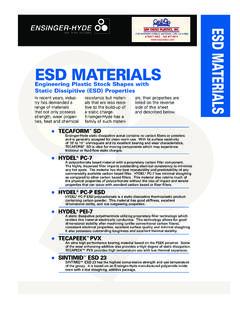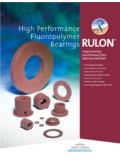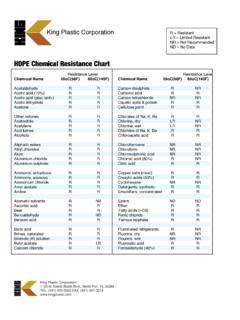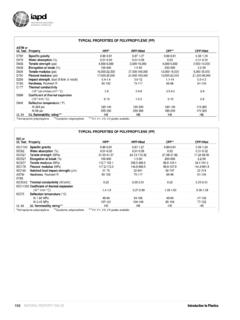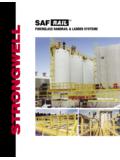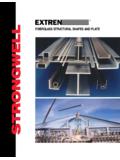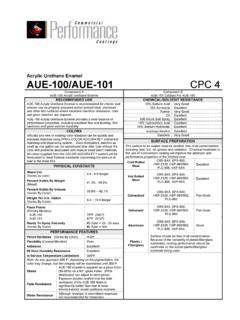Transcription of Acrylite FF Physical Properties Brochure
1 Acrylite FF acrylic sheet is a continuously manufactured acrylic sheet . It is pro-duced by an innovative process, resulting in a sheet offering the easy handling andprocessing of extruded sheet , along with the high optical characteristics and lowstress levels expected of cast products. Colorless Acrylite FF sheet carries anexclusive 10-year limited warranty on light transmission your assurance of aquality product. A printed copy of the warranty is available from CYRO Industries orwherever Acrylite acrylic sheet is clarity and light stability of acrylic resin make it possible to manufacturecrystal clear Acrylite FF FF sheet is a lightweight, rigid and weather-resistant FF sheet is dimensionally stable and resistant to breakage, and can beeasily sawed, machined, heat-formed and of its virtually distortion-free clarity, it is well suited for use in a varietyof applications.
2 Skylights Window Glazing Store or P-O-P Displays Signs Window Frames Optical Displays Picture FramingACRYLITE FF sheet is available in thicknesses from ( mm)to (24 mm) and actual sheet sizes from 48 x 96 ( m x m) to100 x 150 ( m x m). Custom sizes are also available. All sheets areprotected with polyethylene film or paper FF sheet is more impact resistant than glass. If subjected to impactbeyond the limit of its resistance, it does not shatter into small slivers, butbreaks into comparatively large pieces. Acrylite FF sheet meets therequirements of ANSI for use as a Safety Glazing material in Buildings(for thicknesses to [ mm - mm]). Acrylite FF sheet will withstand exposure to blazing sun, extreme cold,sudden temperature changes, salt water spray, etc. It will not deteriorate aftermany years of service because of the inherent stability of acrylic FF sheet has been widely accepted for use in school buildings,industrial plants and outdoor Acrylite FF sheet will expand and contract due to changes intemperature and humidity, it will not shrink with age.
3 Some shrinkage occurswhen Acrylite FF sheet is heated to forming temperature, but post-formingstability is FF sheet is only half the weight of glass and 43% the weight FF sheet is not as rigid as glass or metals. However, it is more rigidthan many other plastics such as acetates, polycarbonates or vinyls. Underwind load an acrylic sheet will bow and foreshorten as a result of glazing installations the maximum wind load and the size of the windowmust be considered when the thickness of a panel is to be Acrylite FF sheet is formed into corrugated or domed shapes, rigiditywill be increased and deflection , flat Acrylite FF sheet , if insufficiently supported, may deformpermanently due to continuous loads such as snow, or even their own rigidity obtained by forming will minimize cold the tensile strength of Acrylite FF sheet is 10,000 psi (69 Mpa) atroom temperature (ASTM D 638), stress crazing can be caused by continuousloads below this value.
4 For glazing applications, continuously imposed design loadsshould not exceed 750 psi ( Mpa) at 73 F (23 C). Temporary loads of up to1,500 psi ( Mpa) may be imposed for short durations of time at 73 F (23 C).CharacteristicsAvailabilitySafetyWeat herResistanceDimensionalStabilityLight WeightRigidityCold FlowStrength andStresses2 Localized, concentrated stresses must be avoided. For this reason, andbecause of thermal expansion and contraction, large sheets should never befastened with bolts, but should always be installed in thermoplastic materials, including Acrylite FF sheet , will gradually losetensile strength as the temperature approaches the maximum recommendedfor continuous service 160 F (71 C).Like most other plastics, Acrylite FF sheet will expand and contract from3 to 8 times as much as glass or metals. The designer should be aware of itscoefficient of expansion and make appropriate provisions.
5 A 48 panel willexpand and contract approximately .002 for each degree fahrenheit change intemperature. In outdoor use, where summer and winter temperatures differ asmuch as 100 F, a 48 sheet will expand and contract approximately 3/16 . Sashrabbets must be of sufficient depth to allow for expansion as well asfor FF sheet also absorbs water when exposed to high relative humidi-ties, resulting in expansion of the sheet . At relative humidities of 100%, 80%,and 60%, the dimensional changes are , and , FF sheet can be used at temperatures from -30 F (-34 C) up to+190 F (+88 C), depending on the application. It is recommended thattemperatures not exceed 160 F (71 C) for continuous service, or 190 F (88 C)for short, intermittent use. Components made of Acrylite FF sheet should notbe exposed to high heat sources such as high wattage incandescent lamps,unless the finished product is ventilated to permit the dissipation of , colorless Acrylite FF sheet has a light transmittance of 92%.
6 It iswarranted not to lose more than 3% of its light-transmitting ability in a 10-yearperiod. Contact CYRO Industries for the complete OP-3 acrylic sheet is formulated with ultraviolet absorbers designedto help protect pictures, photographs and posters from the damaging effects ofultraviolet light. Acrylite OP-3 sheet absorbs more than 98% of the radiationin the ultraviolet range below 400 colored Acrylite FF sheet can be used to reduce glare andsolar energy transmittance. Transparent colored sheets are available in a rangeof color wide range of transmittance values enables the architect to select a densitywhich will provide adequate daylight and at the same time will control glare andsolar heat ContractionHeatResistanceLight TransmissionSolarEnergyControlDistributi onof Solar Energy3 TOTALSOLARENERGYTRANSMITTEDSOLARENERGYIN WARDDISSIPATIONREFLECTEDABSORBEDOUTWARD DISSIPATIONACRYLITE FF sheet has excellent resistance to many chemicals including: solutions of inorganic alkalies such as ammonia dilute acids such as sulfuric acid up to a concentration of 30% aliphatic hydrocarbons such as hexane and VM&P naphthaACRYLITE FF sheet is not attacked by most foods, and foods are not affected by is attacked, in varying degrees, by.
7 Aromatic solvents such as benzene and toluene chlorinated hydrocarbons such as methylene chloride and carbon tetrachloride ethyl and methyl alcohols some organic acids such as acetic acid lacquer thinners, esters, ketones and ethersFor a listing of the resistance of Acrylite FF sheet to more than60 chemicals, refer to the table on page FF sheet will soften as the temperature is increased above 195 F(91 C). As the temperature is increased the sheet passes through thethermoelastic state to the thermoplastic state. The change is gradual rather thansharply defined. The forming temperature range is between 290 F and 320 F(143 C and 160 C). Because the sheet gradually becomes thermoplastic,certain procedures should be considered during thermoforming. If the sheet isto be hung in an oven it is necessary to use a continuous clamp rather thanseveral individual clamps.
8 This will prevent the sheet from permanentlydeforming between clamps. If the sheet is to be heated by infrared heaterswhile clamped in a horizontal frame, it may be necessary to control the heatersabove the center of the sheet . This will prevent the center from becoming toohot and sagging under its own sheet will exhibit very little memory after forming and probably will notreturn to its original flat condition if FF sheet will shrink in the machine direction when heated without aframe. sheet thicknesses of .118 ( mm) and greater will shrink no morethan 3%. Thinner thicknesses could shrink FF sheet can be sawed with circular saws or band saws. It can bedrilled, routed, filed and machined much like wood or brass with a slight modifica-tion of tools. Because the sheet softens quickly, it is necessary to keep thecutting tool and machined edge of the sheet as cool as possible.
9 Cooling of thecutting tool is recommended. Tool sharpness and trueness are essential to preventgumming, heat buildup and stresses in the part. Heat buildup at the machined edgecould lead to subsequent stress crazing and therefore must be technology is rapidly being accepted by the industry for quick andaccurate cutting, welding, drilling, scribing and engraving of focus a large amount of light energy on a very small area which isextremely effective for cutting complex shapes in acrylic sheet . The laserbeam produces a narrow kerf in the plastic allowing for close nesting of partsand minimal waste. CO2lasers vaporize the acrylic as they advance resultingin a clean polished edge but with high stress levels; annealing acrylic sheetafter laser cutting is recommended to minimize the chance of crazing duringthe service life of the FF sheet can be cemented using common solvent cements or poly-merizable cements.
10 The most critical factor is good edge preparation of the part to becemented. The edge of the sheet must be properly machined in order to have a squareflat surface and no stresses. Annealing of the part prior to cementing is and cement fumes should not contact formed or polished FF sheet may be annealed at 180 F (82 C) with the heating andcooling times determined by the sheet thickness. An approximate guideline isannealing time in hours equals the sheet thickness in millimeters and the cooldownperiod is a minimum of 2 hours ending when sheet temperature falls below 140 F. Forexample, 1/8 (3 mm) Acrylite FF sheet would be heated for 3 hours at 180 F (82 C)and slowly cooled for 3 MachiningLaser CuttingCementingAnnealing4 Acrylite FF sheet is a combustible thermoplastic. Precautions should be taken to protect this material from flames and high heat sources.
